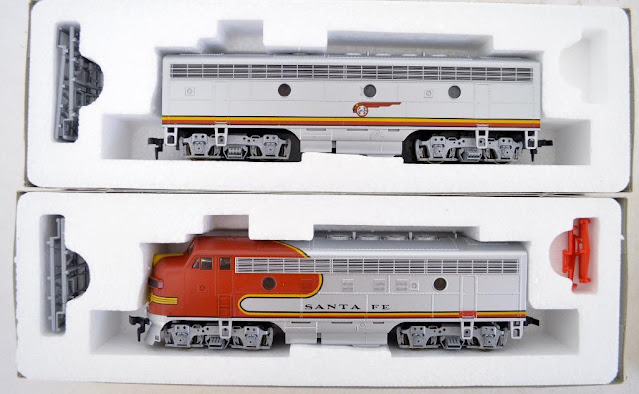This time we'll look at Santa Fe's EMD passenger F7 diesels as they operated through Victorville. Then we'll look at the design for another staging control panel (the Reversing Tower), and we'll see some more progress in laying down cork sheets to support the staging yards.
Santa Fe got their first passenger F7s, #37-41 (ABBA sets), in Sep. 1949, in the famous Warbonnet paint scheme. A month later they got some ABB sets, #300-305. These all had the "Phase 1 Early" body style. In May of 1950 they got more ABB sets, #306-312, which were Phase 1 Late.
For the details on all the phases of Santa Fe's F-units, which I helped document many years ago, see Jim Fuhrman's website at: http://trainweb.org/jfuhrtrain/CF7frames/F3Phases/F2F3F5chart.html
In June of 1951 they got ABB sets #313-316 (Phase 1 Late). Their final ABBA sets, #42-47, arrived in Oct. 1952. These and later units were all Phase 2. In Nov. 1952 they renumbered 306-316 to 325-335. In April-May of 1953 they got ABB sets 336-340, and in April 1953 they got AB sets 341-344, which were their final passenger F7s.
Here we see new F7 ABBA set #38 at the San Bernardino depot, thanks to Jack Whitmeyer:
Here is F7 ABBA set #40 coming through Summit with the westbound Super Chief (running late), as shot by Robert Hale in 1950:
Here is #40 again, running eastbound through the Lower Narrows of Victorville with the new 1956 Hi-Level El Capitan, in a Santa Fe publicity photo:
In this amazing photo from the Al Chione collection, we see an F7 ABB set trailing a 4-unit F3 set entering Summit with the Grand Canyon in an eastbound power move to Barstow, while a UP freight is heading west in Nov. 1953:
Here we see F7 ABB set #340 in a westbound power move with a freight train at Frost, just after leaving Victorville in July, 1953, as shot by Stan Kistler:
Robert Heuerman shot F7 ABBA set #46 with the eastbound El Capitan in Blue Cut in 1953:
Finally, Chard Walker shot F7 ABB set #301 with the eastbound Grand Canyon approaching Summit:
There have been lots of HO models of these famous Warbonnet F7s, in various body phases. For example, here is a Stewart set:
And here is a Walthers Proto 2000 set:
Here is a Broadway Limited set:
And an Athearn Genesis set:
And an MTH set:
Now it's time for my bi-weekly layout progress report.
My friend Bill Messecar returned again on the next Thursday morning to help me with the layout. He cut and fit the final cork sheets for the near end of the large peninsula, and then he proceeded to glue them down with caulk, as seen in this photo:
I worked on stringing the bus wires for the inner mainline in the helix room, and I put a lot of loose passenger cars back into their boxes to get them out of the way.
Now I need to pause my work on the layout (except for when helpers visit me) to prepare a slide presentation for the local Santa Fe Mini-Meet on March 18. The topic will be the concept and design of my Victorville layout.

















No comments:
Post a Comment